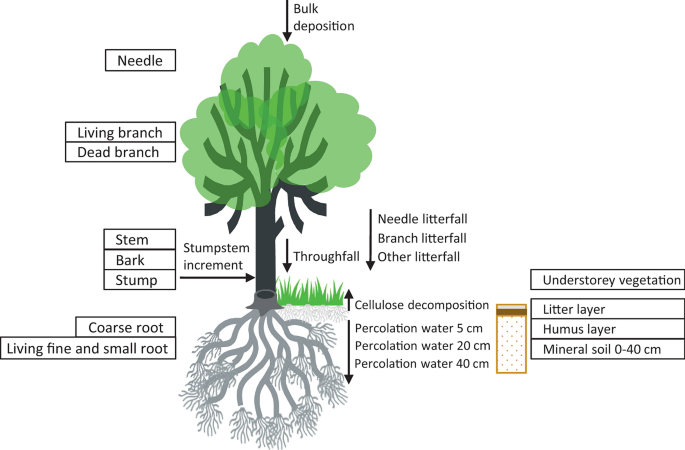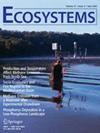Carbon Stocks and Transfers in Coniferous Boreal Forests Along a Latitudinal Gradient
IF 3.3
2区 环境科学与生态学
Q2 ECOLOGY
引用次数: 0
Abstract
Abstract Carbon (C) sequestrated in the boreal forest ecosystems plays an important role in climate regulation. This study’s objectives were to quantify the differences in the components of the forest C cycle along a 1000 km latitudinal gradient within the boreal region and between dominant coniferous species in Fennoscandia. The study included seven xeric–sub-xeric and eight mesic–herb-rich heath forests dominated by Scots pine and Norway spruce, respectively. The total site carbon stock (CS) ranged from 81 to 260 Mg ha −1 . The largest ecosystem component CSs were tree stems, mineral soil, and humus layer, representing 30 ± 2%, 28 ± 2%, and 13 ± 1% of total CS, respectively. On average, the spruce sites had 40% more C than the pine sites, and CS stored in most compartments was higher on spruce than on pine sites. As exceptions, understorey vegetation and litter layer had a larger CS on pine than on spruce sites. The northern sites had an average of 58% less C than the southern sites. Humus layer CS was the only compartment showing no latitudinal trends. Northern sites had a significantly larger fine and small root CS and understorey CS than southern sites. Most CS compartments were significantly correlated with litterfall C transfer components. Dissolved organic carbon (DOC) flux in throughfall was positively correlated with the aboveground tree compartment CS. Our study revealed patterns of C distribution in major boreal forest ecosystems along latitudinal and fertility gradients, which may serve as a reference for Earth system models and in the evaluation of their projections.

针叶林碳储量和碳转移的纬向梯度
寒带森林生态系统固碳在气候调节中起着重要作用。本研究的目的是量化芬诺斯坎迪亚北部地区沿1000公里纬度梯度和优势针叶林物种之间森林C循环成分的差异。该研究包括7个干旱-亚干旱和8个以苏格兰松和挪威云杉为主的富含杂交种草本植物的荒原林。站点总碳储量(CS)为81 ~ 260 Mg ha−1。最大的生态系统组分是树干、矿质土和腐殖质层,分别占总CS的30±2%、28±2%和13±1%。平均而言,云杉样地的碳含量比松林样地高40%,且云杉样地的碳含量高于松林样地。作为例外,松树林下植被和凋落物层的CS大于云杉地。北部遗址的碳含量比南部遗址平均低58%。腐殖质层CS是唯一没有纬度变化趋势的隔室。北方样地细、小根CS和林下CS显著大于南方样地。大部分CS区室与凋落物C传递组分呈显著相关。穿透物中溶解有机碳(DOC)通量与地上树室CS呈正相关。研究结果揭示了主要北方森林生态系统C在纬向和肥力梯度上的分布规律,可为地球系统模型及其预估评价提供参考。
本文章由计算机程序翻译,如有差异,请以英文原文为准。
求助全文
约1分钟内获得全文
求助全文
来源期刊

Ecosystems
环境科学-生态学
CiteScore
8.20
自引率
2.70%
发文量
71
审稿时长
1.7 months
期刊介绍:
The study and management of ecosystems represent the most dynamic field of contemporary ecology. Ecosystem research bridges fundamental ecology and environmental ecology and environmental problem-solving, and spans boundaries of scale, discipline and perspective. Ecosystems features a distinguished team of editors-in-chief and an outstanding international editorial board, and is seen worldwide as a vital home for publishing significant research as well as editorials, mini-reviews and special features.
 求助内容:
求助内容: 应助结果提醒方式:
应助结果提醒方式:


